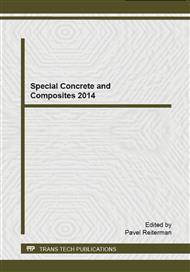[1]
W. Brameshuber, Textile reinforced concrete, State-of-the-Art Report of RILEM Technical Committee 201-TRC. RILEM Publ. S.A.R.L., Bagneux, France, (2006).
Google Scholar
[2]
P. Hájek, M. Kynčlová, C. Fiala, Material effective building structures using high performance concrete, World Sustainable Building Conference, Helsinki, (2011).
Google Scholar
[3]
P. Aitcin, High-Performance Concrete (Modern Concrete Technology), CRC Press, ISBN 0419192700, (1998).
Google Scholar
[4]
J. Hegger, Exterior cladding panels as an application of textile reinforced concrete, ACI Special Publication 224 (2004).
Google Scholar
[5]
P. Hájek, C. Fiala, M. Kynčlová, Life cycle assessment of concrete structures – a step towards environmental savings, Structural Concrete, Vol 12, (2011) Issue 1, ISSN 1464-4177: 13-22.
DOI: 10.1002/suco.201000026
Google Scholar
[6]
C. Fiala, M. Kynčlová, Methodology of Life Cycle Assessment of Structures from High Performance Concrete, 9th conference Special Concrete, Skalský Dvůr, Sekurkon, ISBN 978-80-86604-58-9, (2012).
Google Scholar
[7]
M. Kynčlová, Environmentally effective waffle floor structures from fibre concrete, in: Proceedings of the 8th fib International PhD Symposium in Civil Engineering, Department of Civil Engineering, Technical University of Denmark, Lyngby, (2010).
Google Scholar
[8]
ČSN EN 12390-3: Zkoušení ztvrdlého betonu - Část 3: Pevnost v tlaku zkušebních těles, Vydavatelství ÚNM, Praha, (2009).
Google Scholar
[9]
ČSN EN 12390-5: Zkoušení ztvrdlého betonu - Část 5: Pevnost v tahu ohybem zkušebních těles, Vydavatelství ÚNM, Praha, (2009).
Google Scholar
[10]
S. Fiala, Optimalizace betonových konstrukcí v environmentálních souvislostech, Nakladatelství ČVUT, 2011. ISBN 978-80-01-04663-0.
Google Scholar
[11]
Institut Bauen und Umwelt e.V. (IBU), EPDs http: /construction- environment. com/hp4086/Fibre-glass-mesh. htm.
Google Scholar
[12]
P. Hájek, M. Kynčlová, C. Fiala, Environmentální aspekty využití vláknobetonů v konstrukcích budov, 15th Czech Concrete Days, Czech Republic, (2008).
Google Scholar


